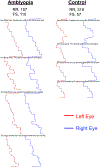Amblyopia and the whole child
- PMID: 36736071
- PMCID: PMC9998377
- DOI: 10.1016/j.preteyeres.2023.101168
Amblyopia and the whole child
Abstract
Amblyopia is a disorder of neurodevelopment that occurs when there is discordant binocular visual experience during the first years of life. While treatments are effective in improving visual acuity, there are significant individual differences in response to treatment that cannot be attributed solely to difference in adherence. In this considerable variability in response to treatment, we argue that treatment outcomes might be optimized by utilizing deep phenotyping of amblyopic deficits to guide alternative treatment choices. In addition, an understanding of the broader knock-on effects of amblyopia on developing visually-guided skills, self-perception, and quality of life will facilitate a whole person healthcare approach to amblyopia.
Keywords: Amblyopia; Child development; Deep phenotyping; Whole person health.
Copyright © 2023 Elsevier Ltd. All rights reserved.
Conflict of interest statement
Declaration of competing interest None of the authors has a financial conflict of interest with the material presented in this manuscript.
Figures
















References
-
- Aljohani S, Bailey J, Perno L, et al., 2020. The feasibility of an educational cartoon video to improve compliance with patching in amblyopic children. Invest. Ophthalmol. Vis. Sci 61, 506.
Publication types
MeSH terms
Grants and funding
LinkOut - more resources
Full Text Sources
Other Literature Sources
Medical

